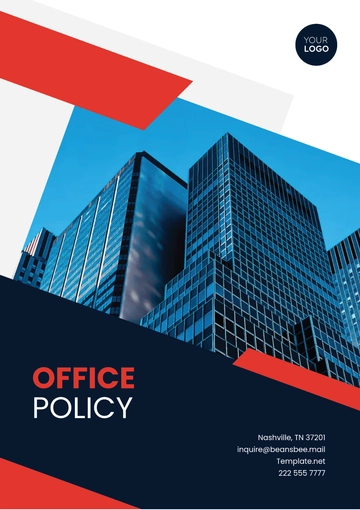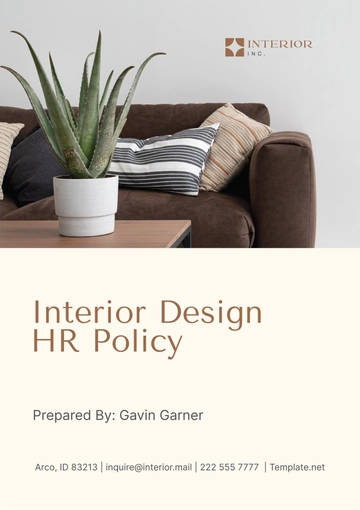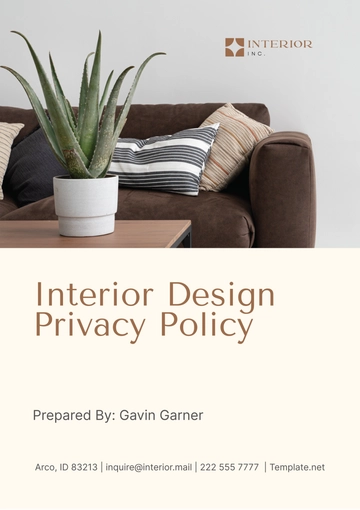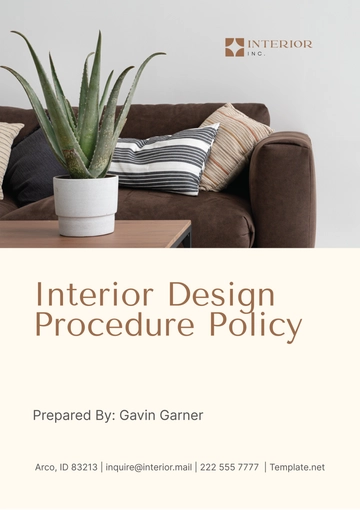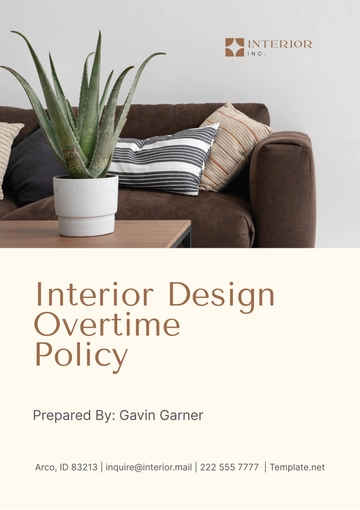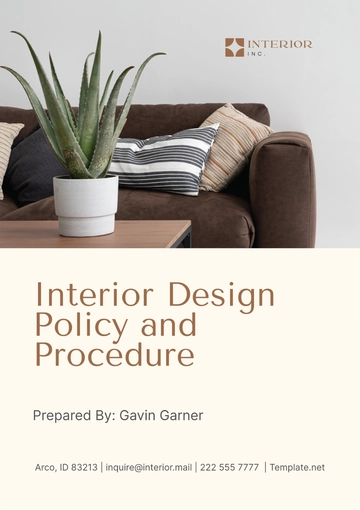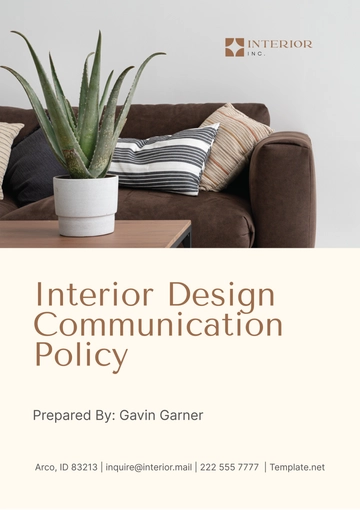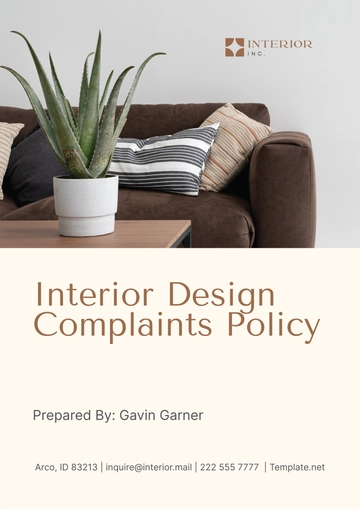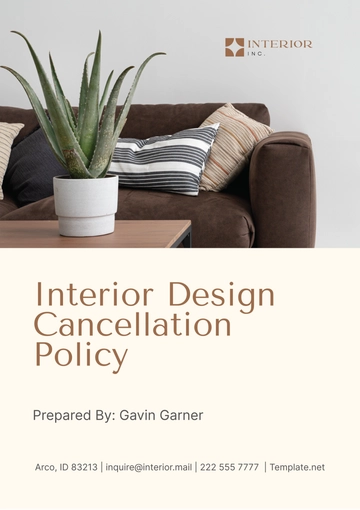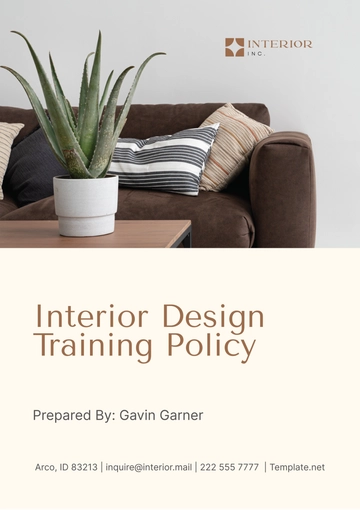Free Interior Design HR Policy

I. Introduction
A. Purpose
The purpose of this Interior Design HR Policy is to establish guidelines and procedures for the management of human resources within [Your Company Name], ensuring a productive and harmonious work environment for all employees. This policy outlines the principles, expectations, and practices governing recruitment, employment, benefits, conduct, and compliance within the organization.
B. Scope
This policy applies to all employees, contractors, consultants, and temporary workers of [Your Company Name], regardless of position or tenure. It encompasses all aspects of human resource management, including but not limited to recruitment, selection, employment policies, benefits, code of conduct, training, employee relations, and compliance with legal obligations.
II. Recruitment and Selection
A. Equal Employment Opportunity
[Your Company Name] is committed to providing equal employment opportunities to all individuals without regard to race, color, religion, gender, sexual orientation, national origin, age, disability, or any other characteristic protected by applicable law. Discrimination or bias in any form during the recruitment and selection process is strictly prohibited.
B. Recruitment Process
The recruitment process at [Your Company Name] is designed to attract and hire qualified candidates who align with the organization's values, culture, and business objectives. Vacant positions will be advertised internally and externally through various channels, including online job boards, social media platforms, professional networks, and recruitment agencies.
A summary of the recruitment process is provided below:
Recruitment Process Steps | Description |
|---|---|
1. Job Requisition | Department managers submit a job requisition detailing the position requirements and qualifications. |
2. Job Posting | Human Resources posts the job vacancy internally and externally, using appropriate channels. |
3. Application Screening | HR screens received applications to identify candidates meeting the minimum qualifications. |
4. Interviews | Qualified candidates undergo interviews with hiring managers, HR representatives, and/or panels. |
5. Selection Decision | Hiring decisions are made based on candidate qualifications, experience, and cultural fit. |
6. Offer and Onboarding | Successful candidates receive job offers and undergo an onboarding process to join the organization. |
The recruitment process is conducted in compliance with relevant employment laws and regulations, including equal employment opportunity laws, anti-discrimination laws, and privacy regulations.
C. Selection Criteria
Selection criteria for vacant positions are determined based on job-related qualifications, skills, experience, and cultural fit with [Your Company Name]. Hiring decisions are made objectively, without bias or discrimination, to ensure fair treatment of all candidates.
Criteria for evaluating candidates may include:
Relevant education and professional qualifications
Work experience and demonstrated skills
Compatibility with company values and culture
Potential for growth and contribution to the organization
Selection criteria are communicated clearly to hiring managers and selection panels involved in the recruitment process to facilitate consistent and fair decision-making.
D. Onboarding
Upon selection, new employees at [Your Company Name] undergo a comprehensive onboarding process to facilitate their integration into the organization and set them up for success in their roles. The onboarding process covers:
Introduction to company policies, procedures, and culture
Orientation to the physical workspace and facilities
Training on job responsibilities, tools, and systems
Introduction to team members and key stakeholders
Completion of required documentation, including tax forms and employee benefits enrollment
Onboarding is designed to provide new employees with the necessary knowledge, resources, and support to adapt to their roles quickly and become productive members of the team. Managers and colleagues play an active role in welcoming and mentoring new hires during their transition period.
III. Employment Policies
A. Work Hours
Regular work hours for full-time employees at [Your Company Name] are [40] hours per week, typically scheduled from [9:00 AM] to [5:00 PM], Monday through Friday, with a one-hour break for lunch. Part-time employees' work hours may vary based on their agreed-upon schedules.
Flexibility in work hours may be available based on departmental needs and employee preferences, subject to managerial approval. Alternative work arrangements, such as telecommuting or flexible hours, may be considered on a case-by-case basis, provided they do not negatively impact productivity or customer service.
B. Overtime
Overtime work may be required at [Your Company Name] to meet project deadlines, accommodate client needs, or address unexpected business demands. Overtime is defined as any hours worked beyond the standard workweek of [40] hours for full-time employees.
Overtime compensation is provided in accordance with applicable laws and company policies. Non-exempt employees are eligible for overtime pay at a rate of [1.5] times their regular hourly rate for hours worked in excess of [40] hours per week. Exempt employees may be eligible for compensatory time off or other arrangements as determined by management.
C. Leave Policies
[Your Company Name] recognizes the importance of work-life balance and provides employees with various types of paid and unpaid leave to address personal and family needs, as well as to promote employee well-being. The following leave policies apply to eligible employees:
Leave Type | Description | Eligibility |
|---|---|---|
Vacation Leave | Paid time off for employees to take a break from work | All full-time and part-time employees are eligible, with accrual rates based on length of service and employment status |
Sick Leave | Paid time off for employees to recover from illness or injury | All employees are eligible, with accrual rates based on company policy and legal requirements |
Holidays | Paid time off for designated holidays observed by the company | All employees are eligible, with specific holidays determined by company policy and cultural norms |
Bereavement Leave | Paid time off for employees to grieve the loss of a close family member | All employees are eligible, with specific leave duration and eligibility criteria determined by company policy and legal requirements |
D. Performance Evaluation
[Your Company Name] conducts performance evaluations for all employees on an annual basis to assess individual performance, provide constructive feedback, and set goals for professional development. Performance evaluations are an integral part of the performance management process and contribute to employee growth and organizational success.
The performance evaluation process includes the following steps:
Goal Setting: Employees and their supervisors collaborate to establish clear and measurable performance goals aligned with departmental and organizational objectives.
Performance Monitoring: Throughout the evaluation period, supervisors provide ongoing feedback and support to employees, monitoring their progress toward achieving established goals and expectations.
Formal Evaluation: At the end of the evaluation period, supervisors conduct formal performance reviews with employees, assessing their performance against established criteria and providing feedback on strengths, areas for improvement, and development opportunities.
Performance Appraisal: Based on the evaluation, supervisors document employees' performance ratings and discuss any necessary actions, such as recognition, coaching, or performance improvement plans.
Goal Setting for Next Period: Employees and supervisors collaboratively set new performance goals and objectives for the upcoming evaluation period, ensuring alignment with organizational priorities and individual development needs.
IV. Employee Benefits
A. Health and Wellness
[Your Company Name] is committed to promoting employee health and wellness by offering comprehensive health insurance benefits to eligible employees and their dependents. The company provides access to medical, dental, and vision coverage to help employees meet their healthcare needs and protect their well-being.
The health insurance benefits offered by [Your Company Name] include:
Medical Insurance: Coverage for medical services, including doctor visits, hospital stays, prescription drugs, and preventive care.
Dental Insurance: Coverage for dental services, including routine exams, cleanings, fillings, and major dental procedures.
Vision Insurance: Coverage for vision care services, including eye exams, prescription eyewear, and contact lenses.
B. Retirement Plans
[Your Company Name] offers retirement savings plans to eligible employees to help them prepare for a secure and financially stable future. The company provides access to retirement investment options, such as 401(k) plans or similar programs, designed to help employees save and invest for retirement.
Key features of the retirement plans offered by [Your Company Name] include:
Employee Contributions: Employees may contribute a portion of their salary to the retirement plan on a pre-tax or after-tax basis, subject to annual contribution limits set by the Internal Revenue Service (IRS).
Employer Matching Contributions: [Your Company Name] may provide matching contributions to employees' retirement accounts, based on a predetermined formula or percentage of employee contributions, up to a certain limit.
Vesting Schedule: Employee contributions and employer matching contributions may be subject to a vesting schedule, which determines the percentage of contributions that employees are entitled to retain upon meeting certain service requirements.
C. Other Benefits
In addition to health insurance and retirement benefits, [Your Company Name] may offer a range of other employee benefits to enhance the overall compensation package and support employees' well-being and work-life balance. The specific benefits offered may vary based on employee eligibility, job classification, and company policy.
Examples of other benefits that [Your Company Name] may offer include:
Life Insurance: Coverage for employees and their dependents to provide financial protection in the event of death or disability.
Disability Insurance: Income replacement benefits for employees who are unable to work due to illness, injury, or disability.
Flexible Spending Accounts (FSAs): Tax-advantaged accounts that allow employees to set aside pre-tax dollars to pay for eligible healthcare expenses, dependent care expenses, or commuter expenses.
Employee Assistance Programs (EAPs): Confidential counseling services, referrals, and resources to support employees with personal or work-related challenges, including mental health issues, family problems, financial concerns, and substance abuse.
V. Code of Conduct and Ethics
A. Professional Behavior
Employees of [Your Company Name] are expected to conduct themselves with professionalism, integrity, and ethical behavior in all interactions and engagements, both within and outside the organization. Professional behavior encompasses the following principles:
Respect: Treating colleagues, clients, vendors, and other stakeholders with courtesy, dignity, and respect, regardless of differences in background, perspective, or role.
Honesty: Communicating truthfully and transparently in all business dealings, avoiding misrepresentation, deception, or dishonesty.
Integrity: Adhering to high ethical standards and moral principles, acting in the best interests of the company and its stakeholders, and avoiding conflicts of interest.
Accountability: Taking responsibility for one's actions, decisions, and outcomes, and holding oneself and others accountable for meeting commitments and fulfilling obligations.
Confidentiality: Safeguarding confidential and proprietary information belonging to [Your Company Name], its clients, and its business partners, and respecting privacy rights and data protection laws.
Professionalism: Demonstrating professionalism in demeanor, appearance, communication, and conduct, reflecting positively on the company's reputation and brand.
B. Confidentiality
Employees of [Your Company Name] are entrusted with confidential and proprietary information that is vital to the success and competitiveness of the organization. Confidential information includes, but is not limited to, trade secrets, client data, financial records, business strategies, and intellectual property.
Employees must maintain the confidentiality of such information and refrain from disclosing it to unauthorized individuals or entities, both during and after their employment with [Your Company Name]. Confidential information should only be accessed, used, or disclosed on a need-to-know basis and in accordance with company policies and procedures.
C. Conflict of Interest
Employees of [Your Company Name] are expected to avoid conflicts of interest and act in the best interests of the company at all times. A conflict of interest arises when an individual's personal interests or relationships interfere with their ability to make impartial decisions or act in the company's interests.
Examples of situations that may give rise to conflicts of interest include:
Financial interests: Holding a financial stake in a competitor, supplier, or customer of [Your Company Name] that could influence business decisions or relationships.
Outside employment: Engaging in outside employment, consulting, or business activities that compete with or detract from the employee's duties and responsibilities at [Your Company Name].
Personal relationships: Participating in hiring, promotion, or procurement decisions involving family members, close friends, or romantic partners, which may create bias or favoritism.
Gifts and favors: Accepting or offering gifts, favors, or gratuities from suppliers, vendors, or clients that could compromise objectivity or integrity in business dealings.
VI. Training and Development
A. Skills Development
[Your Company Name] is committed to investing in the professional development and growth of its employees through ongoing training, education, and skill-building initiatives. The company provides opportunities for employees to enhance their knowledge, competencies, and capabilities in areas relevant to their roles and career aspirations.
The skills development program at [Your Company Name] includes:
Training Workshops: Instructor-led workshops, seminars, and training sessions covering technical skills, industry trends, best practices, and professional certifications.
Online Learning: Access to e-learning platforms, digital courses, webinars, and self-paced modules on a variety of topics, including leadership development, project management, software proficiency, and soft skills enhancement.
Cross-Functional Training: Opportunities for employees to gain exposure to different departments, roles, and projects within the organization, fostering collaboration, versatility, and a broader understanding of the business.
External Training Resources: Reimbursement or sponsorship for external training programs, conferences, and educational events that support employee development and align with organizational objectives.
B. Career Advancement
[Your Company Name] is committed to fostering a culture of continuous learning, growth, and advancement, where employees have opportunities to realize their full potential and achieve their career aspirations within the organization. The company supports career advancement through the following initiatives:
Performance Reviews: Regular performance evaluations to assess employee progress, identify strengths and areas for improvement, and discuss career goals and development opportunities.
Career Planning: Collaborative discussions between employees and their supervisors to explore career paths, set development goals, and create action plans for skill enhancement and career advancement.
Mentoring and Coaching: Formal or informal mentorship programs pairing employees with experienced mentors or coaches who provide guidance, support, and advice on career development, skill acquisition, and leadership competencies.
Promotion Opportunities: Internal job postings, promotions, and career advancement pathways based on merit, performance, and demonstrated potential, allowing employees to take on new challenges, responsibilities, and leadership roles.
VII. Employee Relations
A. Communication
Effective communication is essential for fostering a collaborative and inclusive work environment at [Your Company Name]. The company encourages open, transparent, and respectful communication among employees, managers, and leadership to facilitate information sharing, collaboration, and problem-solving.
Communication channels at [Your Company Name] include:
In-person Meetings: Regular team meetings, departmental meetings, and town hall sessions for discussing goals, initiatives, updates, and addressing employee questions or concerns.
Email Communication: Use of email for official announcements, project updates, policy changes, and other business-related communications, ensuring timely dissemination of information to relevant stakeholders.
Collaboration Tools: Utilization of digital collaboration platforms, such as Slack, Microsoft Teams, or Asana, for real-time messaging, file sharing, project coordination, and virtual team collaboration.
Employee Feedback Mechanisms: Establishment of feedback mechanisms, such as suggestion boxes, employee surveys, and anonymous feedback channels, to gather input, suggestions, and concerns from employees and take action as needed.
B. Grievance Procedure
[Your Company Name] is committed to resolving employee concerns, complaints, or disputes in a fair, timely, and confidential manner. The company has established a grievance procedure to provide employees with a formal process for addressing workplace issues and seeking resolution through appropriate channels.
The grievance procedure at [Your Company Name] consists of the following steps:
Informal Resolution: Employees are encouraged to attempt to resolve grievances informally by discussing concerns with their immediate supervisor or HR representative. Many issues can be resolved through open communication and mutual understanding at this stage.
Formal Complaint: If the grievance cannot be resolved informally, the employee may submit a formal written complaint to the Human Resources Department, outlining the nature of the grievance, relevant facts, and desired outcome.
Investigation: HR conducts a thorough and impartial investigation into the allegations raised in the formal complaint, gathering evidence, interviewing relevant parties, and assessing the merits of the grievance.
Resolution Meeting: HR facilitates a meeting between the employee and relevant stakeholders to discuss the findings of the investigation, explore possible solutions, and attempt to reach a mutually agreeable resolution.
Appeal Process: If the employee is dissatisfied with the outcome of the resolution meeting, they may have the option to appeal the decision through an escalation process, involving higher-level management or an independent review panel, as appropriate.
VIII. Conclusion
The Interior Design HR Policy of [Your Company Name] serves as a comprehensive framework for managing human resources effectively, promoting employee well-being, and ensuring compliance with legal and ethical standards. By establishing clear guidelines, procedures, and expectations, this policy aims to create a positive work environment where employees can thrive, contribute to organizational success, and fulfill their potential.
Furthermore, [Your Company Name] recognizes the value of employee benefits, such as health insurance, retirement plans, and other perks, in attracting and retaining top talent. The company strives to offer competitive benefits packages that support employee well-being, financial security, and work-life balance.
Should you have any questions or require further clarification regarding this HR policy, please do not hesitate to contact the Human Resources Department at [Your Company Email] or [Your Company Number].
- 100% Customizable, free editor
- Access 1 Million+ Templates, photo’s & graphics
- Download or share as a template
- Click and replace photos, graphics, text, backgrounds
- Resize, crop, AI write & more
- Access advanced editor
Establish clear guidelines and procedures with Template.net's Interior Design HR Policy Template. This customizable document offers a comprehensive framework for defining human resources policies and practices within your interior design firm. Covering areas such as recruitment, employee relations, performance management, and benefits administration. Ensure consistency and compliance with HR regulations. Editable in our Ai Editor Tool for seamless customization to reflect your company's HR policies and requirements.
You may also like
- HR Policy
- Restaurant Policy
- Company Policy
- Accounting Policies and Procedures
- Website Policy
- Privacy Policy
- Safety Policy
- School Policy
- IT and Software Policy
- Law Firm Policy
- Construction Policy
- Interior Design Policy
- Travel Agency Policy
- Education Academic Policy
- Security Policy
- Real Estate Policy
- Expense Policy
- Software Policy
